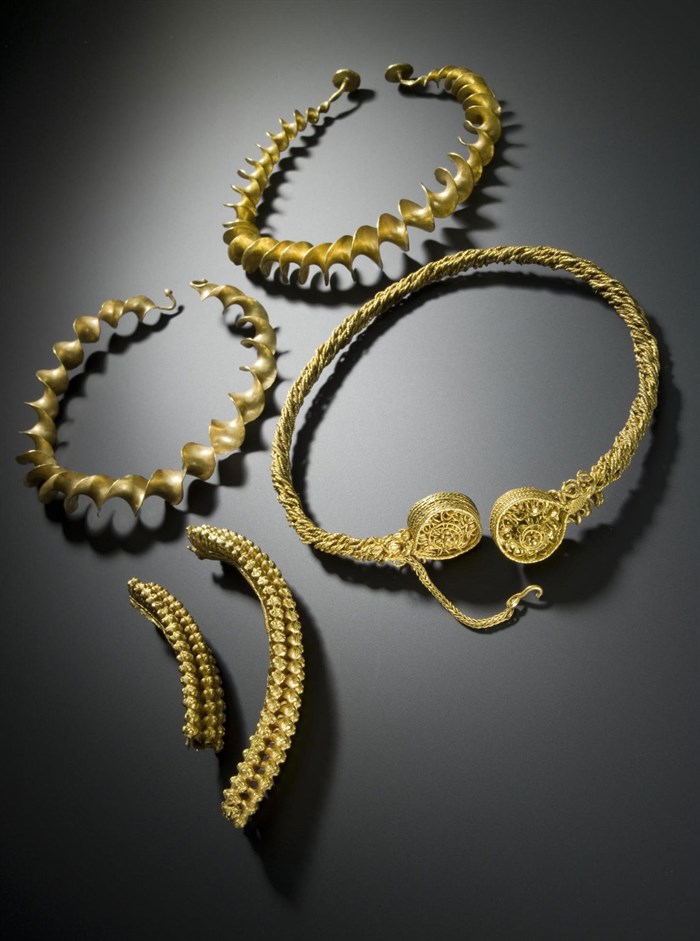British Museum's Celtic Exhibit: A 700 AD Brooch of Silver, Gold and Amber Belonging to 'Melbrigda'
The British Museum, in partnership with National Museums Scotland, has staged the first British exhibition in 40 years on the Celts.

The Riders of the Sidhe, Tempera on canvas, John Duncan, 1911 © Dundee City Council (Dundee's Art Galleries and Museums)
Celts: art and identity at the British Museum on 24 September draws on the latest research from Britain, Ireland and Western Europe. The exhibition tells the story of the different peoples who have used or been given the name 'Celts' through the art objects that they made, including intricately decorated jewelery, highly stylized objects of religious devotion, and the decorative arts of the late 19th century which were inspired by the past. The exhibition will then open at the National Museum Scotland in March 2016.
Today the word 'Celtic' is associated with the distinctive cultures, languages, music and traditions of Scotland, Ireland, Wales, Cornwall, Brittany and the Isle of Man. Yet the name Celts was first recorded thousands of years earlier, around 500 BC, when the ancient Greeks used it to refer to peoples living across a broad swathe of Europe north of the Alps. The Greeks saw these outsiders as barbarians, far removed from the civilized world of the Mediterranean. They left no written records of their own, but today archaeology is revealing new insights into how they lived. Modern research suggests that these were disparate groups rather than a single people, linked by their unique stylized art. This set them apart from the classical world, but their technological accomplishments stand on a par with the finest achievements of Greek and Roman artists.
Gold torcs, National Museum of Scotland, 300 - 100 BC. Found at Blair Drummod, 2009, acquired with the aid of the National Heritage Memorial Fund, the Art Fund and the Scottish Government
 A stunning example in the exhibition, from National Museums Scotland, is a hoard of gold torcs found at Blair Drummond in Stirling in 2009 by a metal detectorist on his very first outing. Excavations showed they had been buried inside a timber building, probably a shrine, in an isolated, wet location. These four torcs made between 300–100 BC show widespread connections across Iron Age Europe. Two are made from spiralling gold ribbons, a style characteristic of Scotland and Ireland. Another is a style found in south-western France although analysis of the Blair Drummond gold suggests it was made locally based on French styles. The final torc is a mixture of Iron Age details with embellishments on the terminals typical of Mediterranean workshops. It shows technological skill, a familiarity with exotic styles, and connections to a craftworker or workshop with the expertise to make such an object. The Blair Drummond find brings together the local and the highly exotic in one hoard.
A stunning example in the exhibition, from National Museums Scotland, is a hoard of gold torcs found at Blair Drummond in Stirling in 2009 by a metal detectorist on his very first outing. Excavations showed they had been buried inside a timber building, probably a shrine, in an isolated, wet location. These four torcs made between 300–100 BC show widespread connections across Iron Age Europe. Two are made from spiralling gold ribbons, a style characteristic of Scotland and Ireland. Another is a style found in south-western France although analysis of the Blair Drummond gold suggests it was made locally based on French styles. The final torc is a mixture of Iron Age details with embellishments on the terminals typical of Mediterranean workshops. It shows technological skill, a familiarity with exotic styles, and connections to a craftworker or workshop with the expertise to make such an object. The Blair Drummond find brings together the local and the highly exotic in one hoard.
Editor's Note: Consult the British Museum Shop jewelry department for copies of some of the the torc pieces
Although Britain and Ireland were never explicitly referred to as Celtic by the Greeks and Romans, some 2,000 years ago these islands were part of a world of related art, values, languages and beliefs which stretched from the Atlantic to the Black Sea. During the Roman period and after the fall of the Western Roman Empire, communities in Ireland and northern and western Britain developed distinct identities. The art and objects which they made expressed first their difference to the Romans, but later the new realities of living in a conquered land or on the edges of the Roman world. These communities were among the first in Britain to become Christian, and missionaries from the north and west helped to convert the pagan Anglo-Saxons.
Pages: 1 · 2
More Articles
- Ferida Wolff Writes: This Holiday Season
- Joan L.Cannon Wrote: A Family Inheritance: More Than 'Things' ... Emblems of Our Lives
- Upcoming Exhibitions at the Fashion Institute of Technology (FIT): Head to Toe and Ravishing: The Rose in Fashion
- Explore the Royal Collection and an Exhibition, Masterpieces From Buckingham Palace
- Frida Kahlo: Appearances Can Be Deceiving: Exceptional Garments Alongside 34 of Her Drawings and Paintings
- Making Marvels: Science and Splendor at the Courts of Europe; Don't Miss The Draughtsman-Writer
- Paris 1900 and the Atmosphere of the Belle Epoque Recreated, A Vibrant and Swiftly Changing City
- Silvia Weidenbach's Jewelry on Display at the Victoria and Albert In an Exhibit Titled Visual Feast
- Chicago Institute of Art and John Singer Sargent, Georg Jensen and Arms, Armor, Medieval, and Renaissance
- Art Nouveau In the Netherlands, a Quest for the 'Truth', the 'Genuine', the Original; Leaving in Architecture and the Decorative Arts






